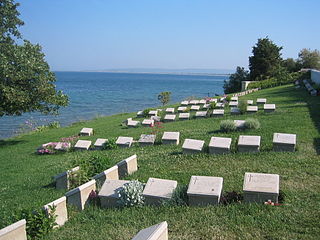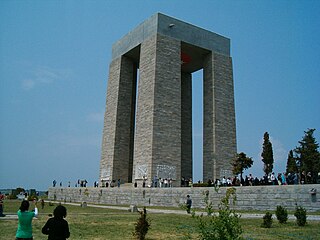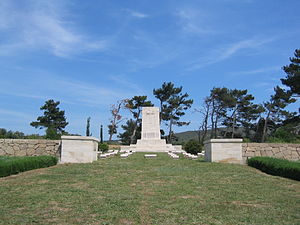
The Gallipoli campaign, the Dardanelles campaign, the Defense of Gallipoli or the Battle of Gallipoli was a military campaign in the First World War on the Gallipoli peninsula from 19 February 1915 to 9 January 1916. The Entente powers, Britain, France and the Russian Empire, sought to weaken the Ottoman Empire, one of the Central Powers, by taking control of the Ottoman straits. This would expose the Ottoman capital at Constantinople to bombardment by Entente battleships and cut it off from the Asian part of the empire. With the Ottoman Empire defeated, the Suez Canal would be safe and the Bosphorus and Dardanelles straits would be open to Entente supplies to the Black Sea and warm-water ports in Russia.
The Battle of Sari Bair, also known as the August Offensive, represented the final attempt made by the British in August 1915 to seize control of the Gallipoli peninsula from the Ottoman Empire during the First World War.

The Battle of Hill 60 was one of the last major assault of the Gallipoli Campaign. It was launched on 21 August 1915 to coincide with the attack on Scimitar Hill made from the Suvla front by Major-General H. de B. De Lisle's British IX Corps, Frederick Stopford having been replaced in the few days previous. Hill 60 was a low knoll at the northern end of the Sari Bair range which dominated the Suvla landing. Capturing this hill along with Scimitar Hill would have allowed the Anzac and Suvla landings to be securely linked.
This article presents the timeline of the Gallipoli Campaign. The period of the proper battle is considered to be 19 February 1915 to 9 January 1916; however, a number of events took place between August 1914 and January 1915 that are relevant to the battle.
Twelve Tree Copse Cemetery is a Commonwealth War Graves Commission cemetery containing the remains of Allied troops who died during the Gallipoli campaign. It is located about one kilometre (0.62 mi) south-west of Krithia on the Gallipoli Peninsula.

Beach Cemetery is a small Commonwealth War Graves Commission cemetery containing the remains of allied troops who died during the Battle of Gallipoli. It is located at Hell Spit, at the southern end of Anzac Cove on the Gallipoli Peninsula.
Walker's Ridge Cemetery is a small Commonwealth War Graves Commission cemetery located near Suvla Bay in Turkey. It contains the remains of Allied soldiers killed during the Battle of Gallipoli.

Quinn's Post Cemetery is a Commonwealth War Graves Commission cemetery from World War I in the former Anzac sector of the Gallipoli Peninsula, Turkey. The battles at Gallipoli, some of whose participating soldiers are buried at this cemetery, were an eight-month campaign fought by Commonwealth and French forces against Turkish forces in an attempt to force Turkey out of the war, to relieve the deadlock of the Western Front (France/Belgium) and to open a supply route to Russia through the Dardanelles and the Black Sea.

The Çanakkale Martyrs' Memorial is a war memorial commemorating the service of about 253,000 Turkish soldiers who participated at the Battle of Gallipoli, which took place from April 1915 to December 1915 during the First World War. It is located within the Gallipoli Peninsula Historical National Park on Hisarlık Hill in Morto Bay at the southern end of the Gallipoli peninsula in Çanakkale Province, Turkey.
Hill 10 Cemetery is a Commonwealth War Graves Commission Cemetery in the former Suvla Bay sector of the Gallipoli Peninsula, Turkey. The battles at Gallipoli, some of whose participating soldiers are buried at this cemetery, was an eight-month campaign fought by Commonwealth and French forces against Turkish forces in an attempt to force Turkey out of the war, to relieve the deadlock of the Western Front (France/Belgium) and to open a supply route to Russia through the Dardanelles and the Black Sea.

Plugge's Plateau Cemetery is the smallest Commonwealth War Graves Commission cemetery on the Gallipoli Peninsula in Turkey. It contains some of soldiers killed during World War I during the battles at Gallipoli, was an eight-month campaign fought by Commonwealth and French forces against Turkish forces in an attempt to force Turkey out of the war, to relieve the deadlock of the Western Front (France/Belgium) and to open a supply route to Russia through the Dardanelles and the Black Sea.

Johnston's Jolly Cemetery is a Commonwealth War Graves Commission cemetery containing the remains of some of the Allied troops who died during the Battle of Gallipoli.

Courtney's and Steel's Post Cemetery is a Commonwealth War Graves Commission cemetery located near ANZAC Cove on the Gallipoli peninsula in Turkey. It contains the graves of some of the former British Empire troops who died during the Gallipoli Campaign.
Baby 700 Cemetery is a World War I Commonwealth War Graves Commission cemetery on the Gallipoli Peninsula in Turkey. It contains the bodies of some of the soldiers killed during the battles at Gallipoli. During an eight-month campaign in 1915, Commonwealth and French forces sought to force Turkey out of the war, which would relieve the deadlock on the Western Front and open a supply route to Russia through the Dardanelles and the Black Sea.
Lala Baba Cemetery is a Commonwealth War Graves Commission cemetery on the Gallipoli Peninsula in Turkey. It contains the remains of some of the soldiers killed during World War I during the battles at Gallipoli. This was an eight-month campaign fought by Commonwealth and French forces against Ottoman Empire forces to try to force the Ottoman Empire out of the war which it was hoped would open a supply route from the Mediterranean to Russia through the Dardanelles and Istanbul and to relieve the deadlock on the Western Front.

Lone Pine Cemetery is a Commonwealth War Graves Commission cemetery dating from World War I in the former Anzac sector of the Gallipoli Peninsula, Turkey and the location of the Lone Pine Memorial, one of five memorials on the peninsula which commemorate servicemen of the former British Empire killed in the campaign but who have no known grave.

The Helles Memorial is a Commonwealth War Graves Commission war memorial near Sedd el Bahr, in Turkey, on the headland at the tip of the Gallipoli peninsula overlooking the Dardanelles. It includes an obelisk which is over 30 metres (98 ft) high.

The battle for No.3 Post was fought during the Gallipoli Campaign in the First World War, between the forces of the New Zealand Mounted Rifles Brigade and the Turkish 19th Division.

The Gallipoli Peninsula Historical Site covers over 33,000 hectares in Gallipoli, Turkey. The park was established in 1973 by the Turkish government and is included in the United Nations list of National Parks and Protected Areas. Gallipoli Peninsula Historical Site is home to memorials, graveyards, and commemorations of events that took place on the peninsula since the First World War.












